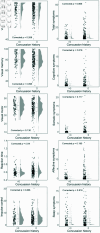Self-reported concussion history is not related to cortical volume in college athletes
- PMID: 40215431
- PMCID: PMC11991726
- DOI: 10.1371/journal.pone.0319736
Self-reported concussion history is not related to cortical volume in college athletes
Abstract
The long-term consequences of concussion are still being uncovered but have been linked to disruptions in cognition and psychological well-being. Previous studies focusing on the association between concussion history and structural changes in the brain have reported inconsistent results. We sought to examine the effect of concussion history on cortical volume with a focus on functional networks. These networks are associated with many of the functions that can be disrupted in those with an extensive concussion history. We collected baseline behavioral data including the Immediate Post-Concussion Assessment and Cognitive Testing, a self-report measure of the number of diagnosed concussions, and structural MRI in college athletes (n=296; 263 men and 33 women, age range 17-24). Behavioral measures were collected by members of the Department of Athletics concussion management team using a standardized protocol as part of their on-boarding process. Collegiate athletes in the present study who self-reported concussion history did not report different baseline symptoms and did not exhibit consistent differences in cognitive performance relative to those who reported no concussion history. We found that concussion history was not related to cortical volume at the network or region level, even when we compared participants with two or more concussions to those with no concussion history. We did identify relationships between cortical volume in the visual network and dorsal attention network with cognitive performance. In addition to comparing cortical volume between individuals with and without reported concussion history, we also examined whether cortical volume changes could be observed within individuals from baseline to acutely following concussion. We found that network level cortical volume did not change within subjects from baseline measurement to acutely post-concussion. Together, these results suggest that both self-reported concussion history and acute concussion effects are not associated with changes in cortical volume in young adult athletes.
Copyright: © 2025 Schultz et al. This is an open access article distributed under the terms of the Creative Commons Attribution License, which permits unrestricted use, distribution, and reproduction in any medium, provided the original author and source are credited.
Conflict of interest statement
The authors have declared that no competing interests exist.
Figures




References
MeSH terms
Grants and funding
LinkOut - more resources
Full Text Sources
Medical

